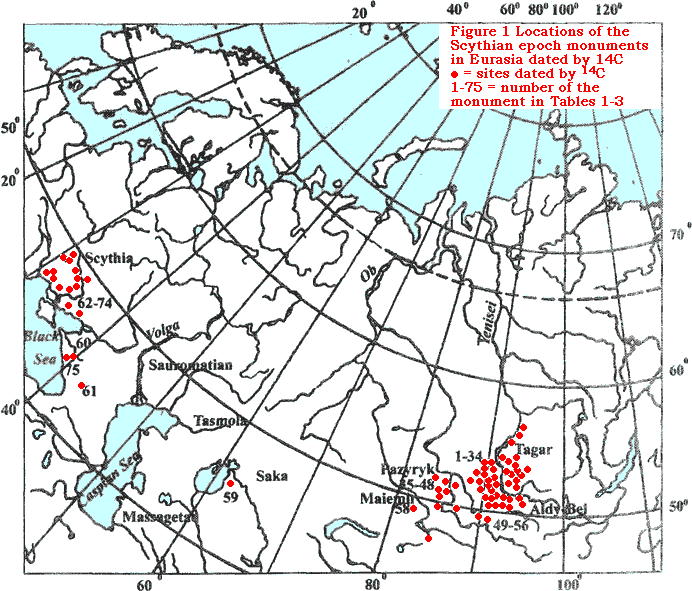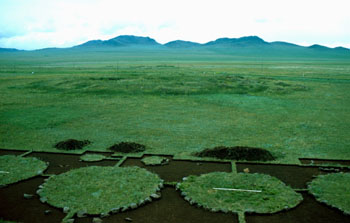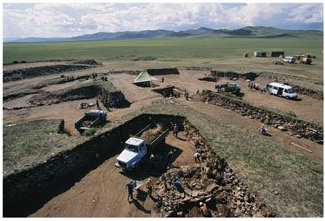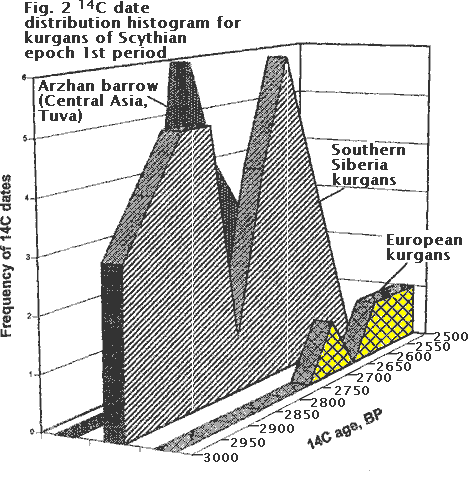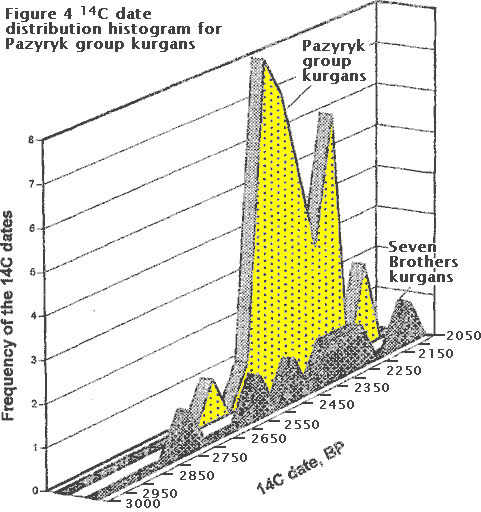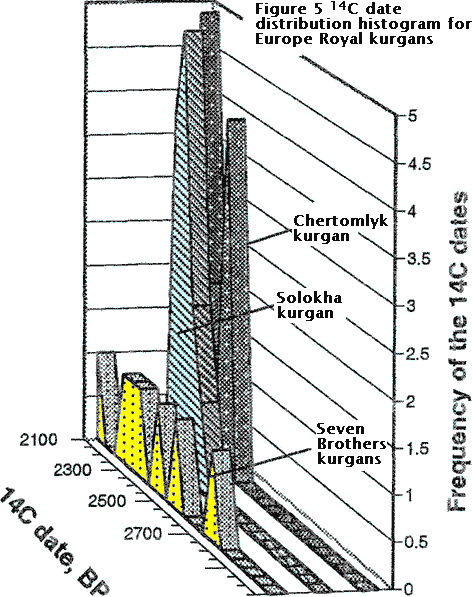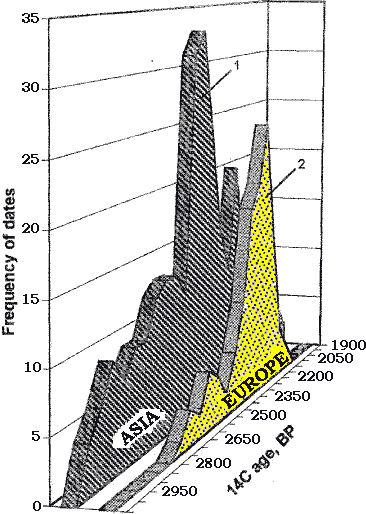Back
Contents Türkic Genetics
Contents Amerin Genetics
Roots
Writing
Language
Religion
Geography
Archeology
Coins
Wikipedia
Avar Dateline
Besenyo Dateline
Bulgar Dateline
Huns Dateline
Karluk Dateline
Kimak Dateline
Kipchak Dateline
Kyrgyz Dateline
Sabir Dateline
Seyanto Dateline
| Scythian-Iranian theory | Ossetian Genetics | Scythian language | Etruscan Genetics | |||||||
Chronology of Eurasian Scythian Antiquities
|
||||||||||
Webmaster's Foreword |
||||||||||
The posted citation is much abbreviated, skipping most of the references and detail tables. The
missing details can be found in the original publication. This posting makes a few superficial
changes in the narrative, reducing a translation flavor left
over from the text in Russian, replacing the surrogate
term "barrow" with the term "kurgan" predominantly used in
Scythian science, replacing "zh" that supposedly indicates "j" like
in "jealousy" to a "j" like in "jealousy",
"Fore-" and "Cis-" to "N." and "S." to avoid
a confusion caused by a
view from a Moscow perch, and getting away from
agglutination of suffixes and endings accumulated in the
Russified place-names.
The last decade's progress in instrumented scientific investigations, analyzed in the University of Arizona report, gives a hope that other monuments in the steppe belt are next in line, to fill in the missing data for huge territories and a multitude of peoples. Scientific instrumented measurements are a necessary step in putting to rest an unending flow of frequently off-base expert speculations and race-driven visions that create a permanent state of confusion built on contradictory "main opinions" about every kurgan and its creators. Considering that nearly every kurgan had at least two opposing guesstimates, the authors' assertion that 14C tests confirm date guesstimates is rather ironic or overly diplomatic, because the tests show continuous development, while the guesstimates tended to conform to a PC concoction of a changeover and disconnected mosaic. Histogram - A bar chart representing a frequency distribution; heights of the bars represent observed frequencies |
||||||||||
ABSTRACT |
||||||||||
1085
The paper compares chronology of the Scythian Epoch monuments located in the east and west of the Eurasian steppe zone comparing archaeological and radiocarbon data. The lists of 14C dates for the monuments located in different parts of Eurasia are presented according to the periods of their existence. Generally, 14C dates confirm archaeological dating, and allowing to compare chronological position of the European and Asian Scythian monuments on a unified 14C time scale. |
||||||||||
INTRODUCTION |
||||||||||
The chronology of Scythian Cultures, which occupied steppe and forest-steppe zones of Eurasia from
Northern China to Danube river during the 1st millennium BC, is very important. For a long time,
chronology of the European Scythian Cultures was based on typological comparisons and historical
sources, while radiocarbon dating played an important role for the Asian Scythian
Cultures. Only
relatively recently the first 14C dates were produced for European Scythian monuments. As a
result, it became possible to compare chronological position of these
Cultures in Europe and Asia
on a unified 14C time scale.
This article summarizes and compares results of research based on archaeological and 14C data with special attention paid to key monuments and definition of preliminary chronology. |
||||||||||
OVERWIEW |
||||||||||
Fig. 1 shows a spread of Cultures belonging to the
Scythian Epoch and the boundaries of
different landscape zones. Most sites are located between - 40°-55°N and 30°-110°E (Fig. 1
includes14C dated sites).
Scythian history can be subdivided into three periods: 1st period - pre-Scythian and initial Scythian Epoch from the 9th to the middle of the 7th centuries BC 2nd period - early Scythian Epoch from the 7th to the 6th centuries BC 3rd period - classical Scythian Epoch from the 5th to the 4th centuries BC. Archaeological dating is based on: For the most part, monuments of the Great Steppe belt, consisting of Kazakhstan, Southern Ural, and Lower Itil River regions, until now have not been dated, as can be seen in Fig. 1. This fact makes difficult a chronological comparison of the nomadic Cultures in the Scythian Epoch over the whole territory of Eurasia. Hopefully, these gaps will be filled in the future.
Fig. 1 Locations of 14C dated
Scythian Epoch monuments in Eurasia |
||||||||||
Pre-Scythian and Initial Scythian
Epoch |
||||||||||
Archaeological Data |
||||||||||
|
1087
The most famous Scythian monument in Central Asia (Tuva) is
Arjan kurgan,
discovered by M P Gryaznov in the 1970s (Tuva was occupied by Stalinist
Russia in 1944, and held since, hence, the "discoveries"
and the "republic"). It is a key monument of the early
Scythian Epoch for all Eurasia.
There are two main opinions on its chronology. According to the first, this monument dates to the 9th century BC or to the 8th century BC. According to the second view, this monument dates to the 7th century BC. Undisputed, however, is that the Arjan kurgan is the earliest monument of the Scythian type in Central Asia. The specific details of its tomb construction, complicated burial tradition, refinement of the weapons, horse equipment, and artifacts would suggest an existence of an earlier stage in the formation of the Scythian-type Cultures in this region in the 10th-9th centuries BC. |
||||||||||
|
||||||||||
The monuments of early
Tagar
Culture of Southern Siberia are closely connected to the Central
Asian antiquities and include among them the Khystaglar,
Large Erba, Kazanov-3 and Shaman Mountain kurgans. For a long time these monuments
were traditionally (i.e.
speculatively and completely wrongly) dated by the 7th century BC. After discovery of the
Arjan kurgan, some archaeologists
suggested dating the initial period of the Tagar Culture
to the 8th century BC. Dating the earliest stage of the Tagar
Culture
is predicated by the dates of the last stage of the
Karasuk Culture,
which preceded
Tagar Culture and
belongs to the final stage of the Bronze Age. On the archaeological evidence,
final stage of the Karasuk Culture existed at about 10th
century BC.
In the European part of the steppe, pre-Scythian period is represented by Chernogor (Black Mountain/Kara Tag) Culture (steppe zone of the Northern Black Sea region) and the antiquities of the Novocherkassk treasure discovered in 1939 (steppe zone of the Northern Black Sea region and Northern Caucasus). For chronology and partial synchronization of these Cultures Klochko and Murzin suggested the following chronological periods: the 10th to the beginning of the 7th century BC for the Novocherkassk Culture and the 9th to the middle of the 8th century BC for the Chernogor Culture. There are other opinions on the chronology of these Cultures. According to one opinion, the period can be subdivided into three periods: 1) pre-Scythian period I, from the 9th to the first half of the 8th century BC (the Chernogor type monuments), 2) pre-Scythian period II, from the middle to the end of the 8th century BC (period of co-existence of Chernogor and Novocherkassk monuments), and 3) pre-Scythian period III, from the end of the 8th to the first half of the 7th century BC (classical Novocherkassk monuments). Alternatively, Kossack restricted existence of the Novocherkassk-type monuments to the end of the 8th century BC, In all cases, the Chernogor type monuments are interpreted as being pre-Scythian, linked to a wave of nomads from the Eastern-Eurasia steppe zone who appeared in the Northern Black Sea region in about the 9th century BC. One of key monuments of pre-Scythian period in the European part of Eurasia is Uash-khitu kurgan in the Northern Caucasus, related to the Novocherkassk Culture and dated by archaeological evidence to the first half of the 7th century BC. The most ancient Scythian monument in Europe is considered to be kurgan No 15 of the Steblev group of kurgans located on the right bank of Dnieper river in a forest-steppe zone. Artifacts from this kurgan are similar to those in the Kazakhstan region and can be dated by the 8th century BC. |
||||||||||
14C Dating |
||||||||||
A 14C chronology for this period has been developed for
the monuments of Southern Siberia and the Central Asian
regions. A number of 14C dates were produced for the
Arjan kurgan whose dating began with its discovery and
continues until the present day. They are widely reported
in the literature. Currently, there are about 30 14C dates for
this monument, confirming its existence at about the
9th—8th century BC. Comparison of the 14C dates for the
monuments of all Eurasia belonging to the 1st period is
difficult because there was a disconnect in dating
between European and Asian monuments, The monuments from
the Asian territory contain more wooden remains suitable
for 14C dating. The dating of these monuments began in the
1960s and continues to the present day. Now there are
about 40 14C dates, which are presented in
Table 1. These
dates confirm the age of the beginning of the Tagar
Culture (to the 7th century BC). For the European
monuments are presented only the most recent 14C dates.
The histogram of the distribution of the 14C dates for the monuments investigated is presented in Fig. 2. 14C dates for the Arjan kurgan were published earlier. This histogram shows co-existence of the Arjan kurgan and the pre-Scythian and Scythian monuments in Southern Siberia (Tagar Culture). In the Arjan kurgan were found Tagar artifacts. The earliest Scythian monuments in Europe appeared some hundred years later. Unfortunately, the Chemogor and Novocherkassk monuments have not been dated yet. Fig. 2 14C date distribution histogram for kurgans of the 1st period Scythian Epoch
|
||||||||||
Early Scythian Epoch (7th to 6th Centuries BC) |
||||||||||
Archaeological Data |
||||||||||
1092 This epoch in Central (i.e. Middle) Asia is represented by the monuments of the so-called Aldy-bel Culture. Aldy-bel is dated by the 8th-6th centuries BC by its burial tradition and typology of artifacts (mirrors and horse bridles). The oldest age (8th century BC) can only be linked to the Ust-Khadynnyg kurgan-1. The main period of the Aldy-bel Culture monuments is suggested to be the 7th—6th century BC. The key monuments of this period in Asia are famous Bashadar and Tuekta kurgans in the Sayan-Altai. There are two archaeological views on their chronology. According to the first, these kurgans are (i.e. speculatively and incorrectly) dated by the 6th century BC. The second view is based on the chronology of the Pazyryk group kurgans (discussed in the next section of this paper). In this case, the chronology of these kurgans can be shifted to the 8th century BC if the interval between the construction of the Tuekta and the Pazyryk-2 kurgans, determined as 128 years, is correct. The monuments of Eastern Kazakhstan, the Maiemir kurgans, were (i.e. speculatively and incorrectly) dated by the 7th century BC. These kurgans were included by some archaeologists in the so-called "Maiemir-Kelermess" phase of the development of Scythia-Siberian Cultures. The chronology of European Scythia is the dates of the individual royal kurgans, which are the milestones for all European Scythian chronology. The most important for Ancient European Scythia is the royal Kelermess monument located in the Northwestern Caucasus (Krasnodar province) and Novozaved (New Shop) kurgans in the Stavropol province in the N.Caucasus region. Earlier, the age of these kurgans was determined to lie on the boundary of the 7th-6th century BC. According to finds of near-eastern origin and analysis of the military-political situation in Asia Minor, some researchers extended the time interval to the middle of the 7th century BC. Thus, there are two chronological systems for these kurgans: a "long" and "short" one. Based on the long chronology, the Kelermess kurgans were (i.e. speculatively and incorrectly) dated by 660-620 BC, based on the short one, they were (i.e. speculatively and incorrectly) dated by the end of the 7th—the beginning of the 6th century BC. The Novozaved kurgans were (i.e. speculatively and incorrectly) dated by 650-590 BC, which is similar to the Kelermess results. |
||||||||||
14C Dating |
||||||||||
For the monuments related to this period, 14C dates were first produced for the Sayan-Altai kurgans of Southern Siberia, the most recent of which were previously unpublished. The first 14C dates were obtained in 1999 for the different kurgans and dated by the 2nd period in the Central Asia (Tuva "Republic") monuments. The 14C dates produced are presented in Table 2. 14C dates for the Tuekta kurgan are not shown in Table 2, but are included in the graphical presentations. In spite of the large number of dates, position of the Tuekta kurgan on the calendar time scale was inconclusively determined due to a complicated character of the calibration curve. The 14C dates for the Tuekta monument corresponded to two positions on the calibration curve: 6th and 5th century BC. In the future, the position of the Tuekta kurgan will be determined more precisely using "wiggle matching" together with dendro validation. The histogram of the distribution of the 14C dates for the monuments belonging to the 2nd period for both the Asian and European parts of Eurasian territories is shown in Fig. 3. Monuments of the 2nd period of the Scythian-type cultures for the Southern Siberia and Central Asia regions have their oldest dates overlapping with those of the Sayan-Altai and European regions. According to the 14C dates, the early Scythian monuments in Europe (the Kelermess and Novozaved kurgans) existed roughly (a little earlier) at the same time as the Tuekta and Bashadar kurgans in the Sayan-Altai. Fig. 3 14C date distribution histogram for Eurasian kurgans of the Scythian Epoch 2nd period
|
||||||||||
Classical Scythian Epoch (5th to 4th Centuries BC) |
||||||||||
Archaeological Data |
||||||||||
1093 Key monuments of the classical Scythian period for the Asian territory are famous Pazyryk group of kurgans. Marasdolov, using a tree-ring chronology, suggested the following chronological succession for the Pazyryk kurgans construction: Pazyryk -2, -1, -4, -3, -5. Per archaeological, tree-ring, and 14C data, he related Pazyryk-2 and 1 kurgans to the middle of the 5th century BC: 455 BC and 454 BC, respectively. The youngest kurgan in this group is Pazyryk-5 kurgan, which was dated by the end of the 5th century BC. There are some analogies in the artifacts and in the kurgan construction between the Pazyryk kurgans and Seven Brothers kurgans in Europe (Kuban region), which are dated by Greek imported objects to the 5th century BC. Another point of view, based on the analyses of the imported objects, date Pazyryk kurgans to the 4th - the beginning of the 3rd century BC. Such dates were accepted by some Russian archaeologists. Further research on the chronology of the Pazyryk kurgans is presented in this issue . Most of over 30 14C dating for these kurgans were published previously. Dogee-Baary-2 kurgans in the Central Asian Tuva "Republic" belongs to the middle stage of the Scythian Epoch. These monuments were investigated for more than 10 years, and the found materials relating to the burial tradition and the culture of the early nomads in this region were dated from the 6th to the 4th century BC. The majority of 14C dates produced for this monument have been published, we here present the 14C dates produced in 1998-1999. In the chronology of Classical Scythia in the forest-steppe zone of the Black Sea region, Steblev monuments play an important role, some kurgans are dated by the 5th - 4th century BC. The most interesting among them is kurgan No 3, which contained Greek amphora dated by 440 BC. The key monuments of Classical Scythia in the European part of Eurasia are Seven Brothers, Solokha, Chertomlyk, Oguz, and Aleksandropol royal kurgans in the Pontic region. According to typological analyses, the oldest among them are Seven Brothers and Solokha kurgans, and the youngest is the Aleksandropol kurgan. The chronological position of the Chertomlyk and Oguz kurgans lies inbetween those. The Seven Brothers kurgans are located in the Taman Peninsula on the left bank of the Kuban River in the Krasnodar province. This monument consists of a group of kurgans belonging to different chronological periods. Thus, kurgan No 4 belongs to the so-called "older group" (460-425 BC), compared with kurgans No 6 (400-380 BC) and No 7 ("younger group") (we know the ethnic name of the Scythian tribe, Onogurs, or "Union of Ten" in Türkic, from whom the Greeks took a name for their antique city Phanagoria/Onoguria). Four famous Scythian royal kurgans are located along a single line 126 km from the Oguz kurgan in the south to the Alexandropol kurgan in the north. From available evidence, the royal tombs were placed along a main transport route, in the center of which is Solokha kurgan, the oldest of them (Yu V Boltrik, personal communication 1999). According to archaeological evidence, Solokha kurgan is dated by 420/410-375 BC. The chronological interval (based on silver ware, smart objects, harness) for the Chertomlyk kurgan is from the 5th to the second half of the 4th century BC. The amphorae's types also give a wide age range. A better date are 350-325 BC. There is some controversy concerning the date of the construction of this kurgan, connected to its use as either: 1. The burial of a well-known Scythian king Ateas (i.e. Atails, another name of the line Atilla, Atatürk, Atabek, ataman etc. that come from "ata" - Türkic "father"), who died in 339 BC (thus timing this kurgan construction to 339 BC), or 2. The burial of the "Anonymous" king who died in the winter of 328/329 BC.
According to the archaeological artifacts, the Oguz kurgan can be dated by 350-300 BC, or 350-325 BC, and the Aleksandropol kurgan by 330-300 BC. |
||||||||||
14C Dating |
||||||||||
The 14C dates of the monuments belonging to the 3rd period
of the Scythian Epoch are presented in
Table 3. The majority of
the dates were produced in the 1996-99, particularly for the
European Scythian monuments. The table includes dates for
Southern Siberian ordinary monuments received
earlier but not yet published.
Both the earlier and new 14C dates for the Pazyryk group (in
Sayan-Altai), Dogee-Barry-2 and te Kopto kurgans (in
Central Asian Tuva) are based on tree rings were
already published, the newer dates are presented and
discussed in separate reports in this issue, and used for the more precise
dating of the calendar position for these kurgans.
There are similarities in the artifacts of the Pazyryk kurgans (in the Altai) and the Seven Brothers kurgans (in Europe). The histogram of the distribution of the 14C dates for these groups is presented in Fig. 4, which shows that the range of the 14C dates is similar, consistent with the archaeological point of view. A growing number of 14C dates for the European Scythian kurgans, produced during the last decade, allow comparison of the dates for the royal European Scythian kurgans: Seven Brothers, Solokha and Chertomlyk. The histogram of the distribution of the 14C dates for these is presented in Fig. 5. The tombs can be arranged on the relative time scale as follows: Seven Brothers, Solokha and Chertomlyk, which does not conflict with the archaeological data.
|
||||||||||
DISCUSSION |
||||||||||
|
1103 A large territory of the Eurasian Steppe belt in the Scythian Epoch was populated by a mosaic of nomadic cultures called by (ancient historians and modern scientiscts with a blend of) different (exo- and endo- and totally random, and even misnomer) names in different regions: Scythians in Europe, Sauromatians in the Lower Itil and Caspian Sea, Southern Ural regions, Tasmola and Saka Cultures in Western Kazakhstan, Maiemir and Pazyryk Cultures in the Sayan-Altai, Tagar Culture in Southern Siberia, Aldy-bel Culture in Central Asia (Fig. 1). For a long time, the chronology of these cultures was approached differently, caused by a (grotesque) lack of 14C dates for the European Scythian monuments, which "chronology" was based on archaeological analogies with different imported objects. The majority of European Scythian monuments were excavated (and thorough destructed without preserving forensic evidence for future studies) before 14C dating was available. The monuments in the Asian territory contained material suitable for 14C dating, mostly remains of wood from the kurgans' construction. Dating of the Southern Siberia, Central Asia and Sayan-Altay regions' monuments began in the 1960es. Now, with accelerator mass spectrometry (AMS) can be produced 14C dates for materials from the museum collections. Dating of the European Scythian monuments began in the 1990s. A representative series, including over 200 14C tests for the eastern and western parts of the Great Eurasian steppe Scythian monuments belonging to different time periods allows a comparison of their chronological position on a unified 14C time scale. The histogram of the distribution of all 14C dates for both the eastern and western parts of Eurasian steppe is presented in Fig. 6. As seen in this histogram, beginning of the Scythian Cultures in Europe fall some hundreds of years later than in Asia, which does not contradict the most recent archaeological theories. Addition of the 14C (still missing) dates for the Chernogor type monuments in Europe would allow a refinement of this comparison. Together, the 14C chronology of the Scythian monuments for
different time periods is consistent with
("the most recent ")
archaeological theories as can be seen in Tables 1-3 and results mentioned above.
In this comparison, the results on the
absolute/calendar chronology are not so important
(why?). |
||||||||||
|
||||||||||
CONCLUSION |
||||||||||
|
1105 Series of 14C dates for the monuments of Eurasia Scythian Epoch are consistent with ("the most recent") existing chronological and archaeological theories. The three periods of Scythian history confirmed in this research are in concordance with the categorization suggested by Gryaznov (1979) based on the synchronization typology of the key monuments: 1) The Arjan-Chernogor phase: 8th-7th century BC, 2) the Maiemir-Kelermess phase: 7th-6th century BC, and 3) the Pazyryk-Chertomlyk phase: 5th-3rd century BC. Lack of reliable imported objects in the Scythian monuments of Central Asia and Siberia enhances the role of scientific methods including dendrochronology and 14C dating (sometimes incorporating wiggle matching) in piecing together a unified chronology for these cultures. |
||||||||||
ACKNOWLEDGMENT |
||||||||||
|
This research is supported by
INTAS, project No 97-20362 |
||||||||||
REFERENCES |
||||||||||
|
1105 Alekseev AYu. 1992. Scythian chronic (Scythian in the
7th-tke 4th century BC: historical archaeological review).
St. Petersburg: Petersburg Comstat Press. 210 p. In
Russian. |
||||||||||
|
||||||||||
